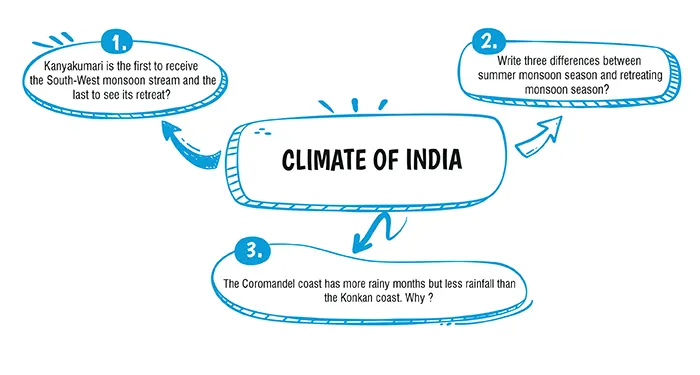Table of Contents

Ans. (B) Tropic of Cancer
Explanation:
India has a tropical monsoon type of climate. This is because India lies in the tropical belt and its climate is influenced by the monsoon winds. Hot summers and dry winters are characteristic of the monsoon type of climate.
Ans. D) Himalayas
Explanation:
Rainfall is scarce in the Rajasthan region because of the monsoon branch entering through Gujarat which runs parallel to the Aravalli ranges.
Explanation:
The West Coast region is the first to receive rain from the South-West monsoon. Hence, Kanyakumari is the first to receive the South-West monsoon stream. By the first week of October, the South-West monsoon begins to withdraw from India since Kanyakumari is the last station to see the retreat of the South-West monsoon.
Explanation:
| Summer Monsson | Retreating Monsoon |
|---|---|
| (i) Low pressure is over the land. | Low pressure is over the sea. |
| (ii) Winds blows from the sea towards the land. | Winds blows from the land towards the sea. |
| It brings rain to most parts of India. | It brings rain only in Tamil Nadu and Odisha. |
Explanation:
Konkan coast faces onshore South-West Monsoons during summer. These moisture laden winds give heavy rainfall (more than 300 cm.). But these winds do not give much rainfall on the Coromandel coast as it lies in the rain shadow of the Western Ghats. Coromandel coast also receives winter rainfall from North East monsoons, but on Konkan coast these winds are offshore and do not give any rainfall. North-East Monsoon is a dry wind as it blows from the land. Thus, Coromandel coast gets rainfall in both the seasons, but the total rainfall amount is less than that of Konkan coast.
Download Mind Map of this chapter
Download NowWant to Practice Mock Tests of this chapter
Practice NowDownload Important Questions of this chapter
Download Now| Chapter No. | Chapter Name |
|---|---|
| Chapter 1 | Map Study: Interpretation of Topographical Maps |
| Chapter 2 | Map of India |
| Chapter 3 | Location, Extent and Physical features |
| Chapter 4 | Climate of India |
| Chapter 5 | Soil Resources |
| Chapter 6 | Natural Vegetation of India |
| Chapter 7 | Water Resources |
| Chapter 8 | Mineral and Energy Resources |
| Chapter 9 | Agriculture In India |
| Chapter 10 | Industries in India: Agro Based |
| Chapter 11 | Industries in India: Mineral Based |
| Chapter 12 | Transport in India |
| Chapter 13 | Waste Generation and Management |
CBSE Important Questions Class 10
ICSE Important Questions Class 10
CBSE Important Questions Class 10
ICSE Important Questions Class 10